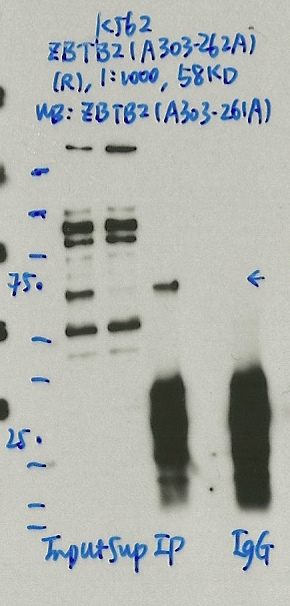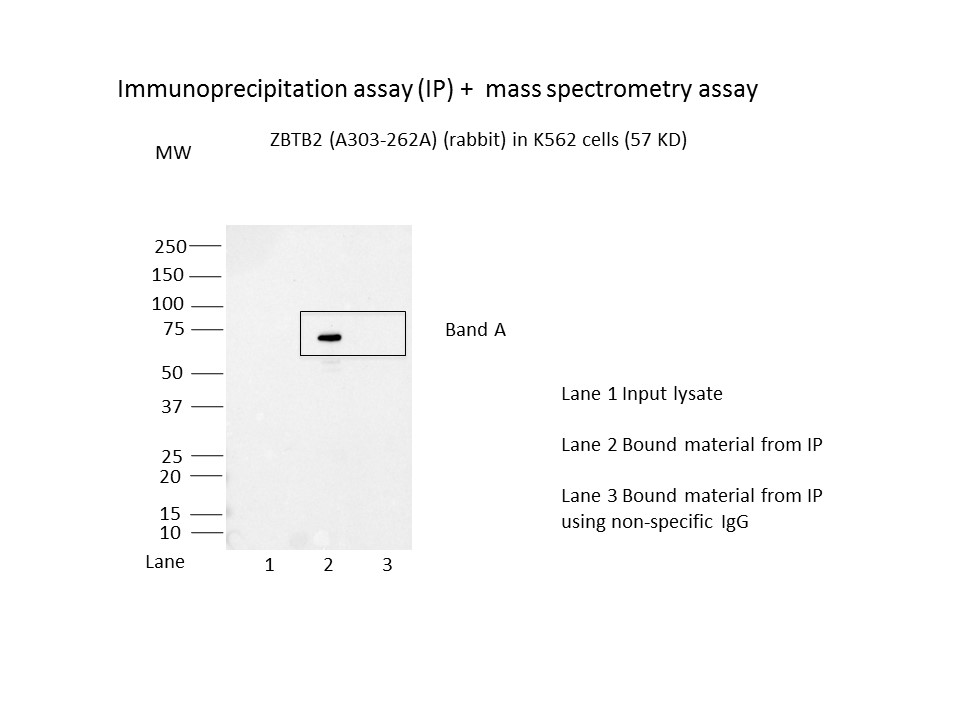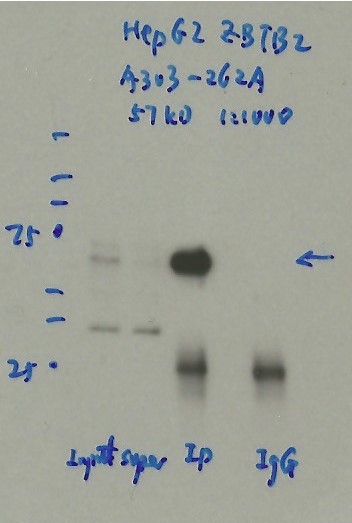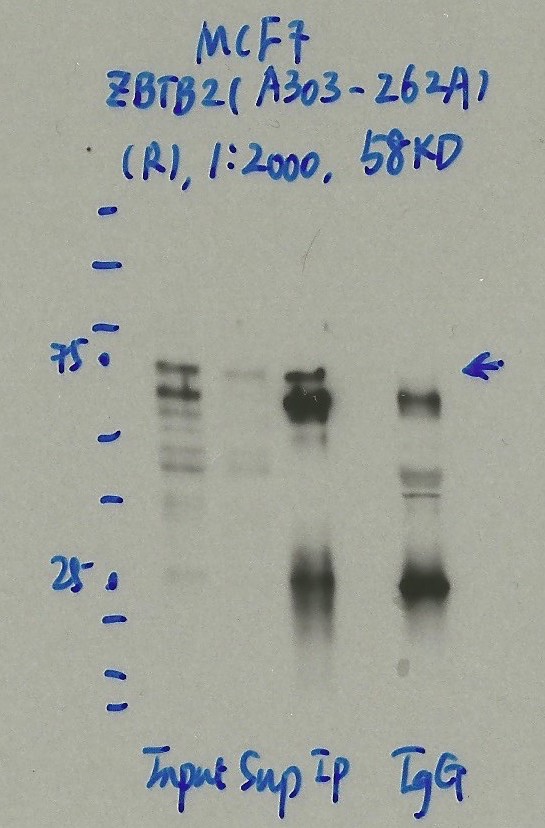ENCAB543JMP
Antibody against Homo sapiens ZBTB2
Homo sapiens
K562, MCF-7, HepG2
characterized to standards with exemption
- Status
- released
- Source (vendor)
- Bethyl Labs
- Product ID
- A303-262A
- Lot ID
- 1
- Characterized targets
- ZBTB2 (Homo sapiens)
- Host
- rabbit
- Clonality
- polyclonal
- Purification
- affinity
- Aliases
- michael-snyder:AS-1469
- External resources
Characterizations
ZBTB2 (Homo sapiens)
K562
not compliant
- Caption
- Immunoprecipitation was performed on nuclear extracts from the cell line: K562, using the antibody A303-262A. The blot shows western blot analysis of input, flowthrough, immunoprecipitate and mock immunoprecipitate using IgG.Molecular Weight: 57.337
- Reviewer comment
- Band is too high in size, beyond the allowable 20% of expected size.
- Submitted by
- Denis Salins
- Lab
- Michael Snyder, Stanford
- Grant
- U54HG006996
- Download
- 1075_01_ZBTB2_A303-262A.jpg
ZBTB2 (Homo sapiens)
K562
exempt from standards
- Caption
- Immunoprecipitation was performed on nuclear extracts from the cell line K562 using the antibody A303-262A. Lane 1: input nuclear lysate. Lane 2: material immunoprecipitated with antibody. Lane 3: material immunoprecipitated using control IgG. Marked bands were excised from gel and subjected to analysis by mass spectrometry. Target molecular weight: 57.337.
- Submitter comment
- We detected ZBTB2 by mass spec in the marked immunoreactive band.
- Reviewer comment
- Runs higher than expected size but ZBTB2 is detected by accompanying mass spec.
- Submitted by
- Nathaniel Watson
- Lab
- Michael Snyder, Stanford
- Grant
- U54HG006996
- Download
- MS1038_2_ZBTB2-A303-262A_lighter.jpg
ZBTB2 (Homo sapiens)
HepG2
exempt from standards
- Caption
- Immunoprecipitation was performed on nuclear extracts from the cell line: HepG2 using the antibody A303-262A. The image shows western blot analysis of input, flowthrough, immunoprecipitate, and mock immunoprecipitate using IgG. Target molecular weight: 57.337.
- Submitter comment
- Similar in size to K562 IP-MS.
- Reviewer comment
- Runs higher than expected size but banding pattern is consistent across cell types and was detected in similarly-sized band by mass spec in K562.
- Submitted by
- Nathaniel Watson
- Lab
- Michael Snyder, Stanford
- Grant
- U54HG006996
- Download
- Scan_20170330.jpg
ZBTB2 (Homo sapiens)
Method: immunoprecipitation followed by mass spectrometry
exempt from standards
- Caption
- IP followed by mass spectrometry. Briefly, protein was immunoprecipitated from K562 nuclear cell lysates using the antibody A303-262A, and the IP fraction was loaded on a 10% polyacrylamide gel (NuPAGEBis-Tris Gel) and separated with an Invitrogen NuPAGE electrophoresis system. The gel was stained by ColloidialCoomassie G-250 stain, gel fragments corresponding to the bands indicated were excised. Then proteins were trypsinized using the in-gel digestion method. Digested proteins were analyzed on an Orbitrap Elite mass spectrometer (Thermo Scientific) by the nanoLC-ESI-MS/MS technique. Peptides were identified by the SEQUEST algorithm and filtered with a high confidence threshold (Peptide false discovery rate < 1%, 2 unique peptides per protein minimum, mass error < 10 ppm).
- Submitter comment
- RMDN3, NCL, UBC, ALB, C3 are not TFs. FUS, HSPA1A and LAS1L are RNA-binding proteins. Both MTA1 and HDAC1 have interactions with ZBTB2, https://thebiogrid.org/121667/summary/homo-sapiens/zbtb2.html. Also, MTA1 has interaction with HDAC1, 17 publications on biogrid, https://thebiogrid.org/109315/summary/homo-sapiens/hdac1.html. MTA2, CHD4, GATAD2B, ZMYND8, HDAC2, GATAD2A, MTA3 and DDX17 have interactions with HDAC1, https://thebiogrid.org/109315/summary/homo-sapiens/hdac1.html. Both NRF1 and HDAC1 have interactions with HCFC1 and Jun, https://thebiogrid.org/109315/summary/homo-sapiens/hdac1.html and https://thebiogrid.org/110851/summary/homo-sapiens/nfe2l1.html. Also, HCFC1 and HDAC1 are in one complex, http://www.genecards.org/cgi-bin/carddisp.pl?gene=HCFC1&keywords=hcfc1. HCFC1 (209KD) and Jun (36KD) are not in the gel slice with NRF1 (54KD), HDAC1 (55KD) and ZBTB2. PDCD11 is a NFKB1 binding protein, NFKB1 and HDAC1 have interactions, 6 publications on biogrid, https://thebiogrid.org/109315/summary/homo-sapiens/hdac1.html. ZNF800 has interactions with MTA2, https://thebiogrid.org/114652/summary/homo-sapiens/mta2.html. NKRF is NF-KappaB Repressing Factor, NFKB1 and HDAC1 have interactions, 6 publications on biogrid, https://thebiogrid.org/109315/summary/homo-sapiens/hdac1.html.
- Reviewer comment
- ZBTB2 is not the top ranked TF in the peptide list but lab has provided references for interactions with ZBTB2 and interacting partners of ZBTB2.
- Submitted by
- Nathaniel Watson
- Lab
- Michael Snyder, Stanford
- Grant
- U54HG006996
- Download
- ZBTB2_A303-262A final.pdf
ZBTB2 (Homo sapiens)
MCF-7
exempt from standards
- Caption
- Immunoprecipitation was performed on nuclear extracts from the cell line: MCF-7 using the antibody A303-262A. The image shows western blot analysis of input, flowthrough, immunoprecipitate, and mock immunoprecipitate using IgG. Target molecular weight: 57.337.
- Submitter comment
- Similar in size to K562 IP-MS.
- Reviewer comment
- Runs higher than expected size but banding pattern is consistent across cell types and was detected in similarly-sized band by mass spec in K562.
- Submitted by
- Nathaniel Watson
- Lab
- Michael Snyder, Stanford
- Grant
- U54HG006996
- Download
- ZBTB2_A303-262A_MCF7.jpg



